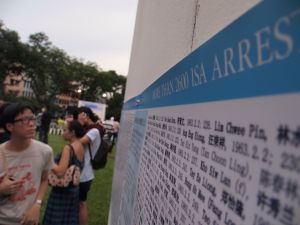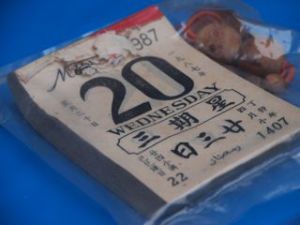by
CHERIAN GEORGE
June 2nd, 2012
Above: This afternoon’s event at Hong Lim Park commemorated the 25th anniversary of Operation Spectrum. It was organised by Maruah and Function 8. Read Yawning Bread’s report of the event.
This year marks the 25th anniversary of Operation Spectrum, the arrests under the Internal Security Act of young Singaporean activists who were labelled Marxist conspirators. The use of the ISA as a means to tame the media is described in my book, Freedom From The Press. Here is an extract from the book.
The list of individuals detained since the PAP came to power in 1959 includes several who were involved in media, although many of them were hauled up not for their media work as such, but for their activities in opposition parties, trade unions and other organisations. Targets of the 1963 crackdown included Singapore National Union of Journalists secretary general A. Mahadeva of The Straits Times and committee member James Fu Chiao Sian of Nanyang Siang Pau (who would later become press secretary to Prime Minister Lee Kuan Yew). Others such as Poh Soo Kai and Tan Jing Quee were involved with the left-wing undergraduate magazine Fajar. Said Zahari, jailed for 17 years, was editor of the opposition Barisan Sosialis party’s Malay newsletter, Rakyat, and before that editor of the Malay daily Utusan Melayu. Lim Hock Siew edited Barisan’s English organ, Plebeian.
In the decade or so after independence, the ISA was used against several individuals working for mainstream Chinese and Malay media organisations. Before the milestone May 1971 crackdown on Nanyang Siang Pau, Ngiam Tong Hai of the same paper (1966) and Julius Yeh Sai Fu of Sin Chew Jit Poh (1971) were detained. Nanyang Siang Pau chairman Lee Eu Seng was detained for five years from 1973. In 1974, three Sin Chew Jit Poh staffers were among 31 people detained as alleged members of the Malayan National Liberation Front. In 1976, Berita Harian editor Hussein Jahidin and assistant editor Nahar Azmi Mahmud were arrested for allegedly sowing discontent and propagating communist thinking among Malays as part of a plot masterminded by the PAP’s left-wing founder member Samad Ismail. In 1977, Min Pao Daily journalist Kwok Chong Kwee was detained for ten days in connection with alleged pro-communist activities. In February 1977, the ISA was directed at the foreign media. Arun Senkuttuvan, who wrote for the Far Eastern Economic Review and other overseas publications, was detained for two months and stripped of his citizenship. Then, in March, the same magazine’s reporter Ho Kwong Ping was detained for seven weeks until 29 April.
Operation Spectrum of 1987 ensnared two individuals who were, among other activities, involved in publishing an underground newsletter that allegedly contained hostile and left-wing views about army life, and two others accused of infiltrating the Workers’ Party organ, Hammer. There were also two subtitling editors with the national broadcaster and a journalist with the Malaysian daily New Straits Times — but these media employees were not accused of using their outlets as part of their Marxist conspiracy. Therefore, Operation Spectrum could not really be characterised as a crackdown on journalism. Instead, the last time the ISA detention was used as an instrument of media regulation was 1977. Ho Kwon Ping, whom the government would appoint 20–30 years later as a statutory board chairman, chairman of the national broadcaster MediaCorp and president of Singapore Management University, would hold the additional distinction of being the last person to suffer ISA detention in the line of professional journalistic duty. Since then, the government has been able to count on the NPPA to create a culture of self-restraint in domestic newspapers. Defamation suits, contempt of court charges, circulation restrictions and work permit controls became the preferred tools for disciplining the foreign media.
There were other signs of a government re-think of its use of the ISA. By the late 1970s, American diplomats were noting that some detainees were being released despite not publicly renouncing communism or armed revolution. Some detainees refused to make such statements on the grounds that this was tantamount to admitting that they had believed in communist revolution in the first place. To break the stalemate, the government was willing to release them with restrictions. As Singapore’s security landscape changed, it may have also occurred to the government that overuse of the ISA would strain credibility. As early as 1977, the US State Department’s human rights report on Singapore registered the fact that the ISA was originally justified in connection with communist insurgency but that the definition of a “security case” was now being extended to include “those who portray Singapore as a state in which individual liberties are curtailed or the Singapore Government as undemocratic, totalitarian, autocratic and ‘oppressive’; and those journalists whose reporting is considered by the Government of Singapore to be slanted and therefore capable of being exploited by communists”.
Operation Spectrum of 1987 dispelled any doubts that a Cabinet made up mainly of second generation leaders had the stomach for using the ISA. In hindsight, though, the swoop could be said to have crossed a threshold — the point of diminishing returns — causing the government to reconsider its menu of coercion. The problem was not the objections from international human rights monitors, the Catholic church or Singapore’s liberals, since the PAP continues to draw a certain macho pride from its immunity to such external pressures. More worryingly, the government was finding it hard to convince even insiders. Goh Chok Tong, who was deputy prime minister at the time, revealed in an interview for the 2009 history of the PAP, Men in White, that his Cabinet colleague S. Dhanabalan “was not fully comfortable with the action which we took”. This, Goh said, was a reason for Dhanabalan’s eventual shock resignation from government. Dhanabalan was no lightweight or liberal: as culture minister, he had banned Cosmopolitan for its permissive values. He had also been named by Lee Kuan Yew as premier-material but for the fact that Singapore’s Chinese majority would not accept an Indian prime minister.
A young civil servant who was questioned as part of the Operation Spectrum investigations, Tharman Shanmugaratnam, voiced his doubts to the press when he was inducted into politics in 2001. “Although I did not have access to the same intelligence as the ISD, basically, those whom I knew had a strong social conscience and did not have a destructive political agenda,” he told The Straits Times in 2001. Tharman would go on to become deputy prime minister. Another establishment figure, legal scholar Walter Woon, who would serve as an ambassador and then briefly as attorney general, expressed his scepticism in 1991. “As far as I am concerned, the government’s case is still not proven. I would not say those fellows were Red, not from the stuff they presented,” he told The Straits Times.
Ironically, the ISA’s obsolescence as a censorship tool was probably sealed in 2001, when it had to be used against a bona fide security threat. The discovery of a Jemaah Islamiyah cell plotting terrorist attacks and with links to Al Qaeda suddenly demanded a more judicious use of the ISA. At all costs, the authorities had to avoid giving Singapore’s Muslims the impression that they were being targeted as a community. Its need for the support and cooperation of the wider Muslim community meant that the government had to act with precision and credibility. It could no longer apply the ISA in as loose and sweeping a fashion as in earlier decades, when anyone critical could be labelled a communist. In the past, it could be said that the government benefited from the climate of fear induced by an ill-defined ISA; post-2001, however, the authorities wanted the ISA to inspire public confidence, not paranoia. After decades of being perceived as a convenient political weapon, it would have to return to its security roots.
Francis Seow’s 1988 detention marked the last fresh arrest of a non-violent political opponent under the ISA. Since then, the Singapore government has honoured an undeclared moratorium on detention orders as a means of controlling dissent. Malaysia provides an interesting contrast. It continued to use the ISA against opposition members and other peaceful activists. As recently as 2008, Malaysia arrested under the ISA a mainstream newspaper journalist for accurately reporting a ruling party politician’s inflammatory outburst. In keeping with the theory of calibrated coercion, Malaysia’s kneejerk use of the law delegitimised the ISA in the eyes of a broad swathe of public opinion and made it a political issue in itself, compelling the Prime Minister Najib Abdul Razak to promise its repeal in 2011 in order to shore up his position. In contrast, Singapore’s human rights activists have had a harder time building up public support against the ISA, which is widely seen as a necessary national security tool.
From:
Freedom From The Press: Journalism and State Power in Singapore, NUS Press, 2012.
Above: A calendar belonging to lawyer Teo Soh Lung. She never got to tear off this page because life as she knew it ended the next day, when she was arrested and detained under the ISA. The calendar and other poignant artifacts were displayed at the Hong Lim Park event. Singaporean human rights group Maruah is organising a petition for a commission of inquiry into the arrests, “so that the nation can truly begin to heal and put this traumatic event in our history behind us”.



Be the first to comment on "Mightier than the pen: Remembering ISA detentions of writers"